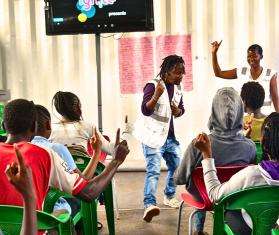NEW YORK, MARCH 1, 2021—A recently published study in Nature shows the feasibility of a new mobile application called Antibiogo that is capable of facilitating the diagnosis of antibiotic resistance, a major public health issue. The application—coordinated by the Doctors Without Borders/Médecins Sans Frontières’ (MSF) Foundation and involving researchers and engineers from the University of Évry, French Alternative Energies and Atomic Energy Commission (CEA), French National Center for Scientific Research (CNRS), MSF, and the bacteriology and virology Department of Henri-Mondor Hospital APHP—will be available free of charge to health workers worldwide once it receives clinical validation and certification.
Antibiotic resistance is a major threat to global health.
The World Health Organization points to the increasing resistance of microorganisms to antibiotics as one of the major health challenges of the 21st century. Antimicrobial resistance could become the world's leading cause of death, causing 10 million deaths per year by 2050 due to the lack of resources. Nearly 90 percent of these deaths are expected to occur in Asia and Africa. The rational use of antibiotics is therefore essential and requires a robust assessment of the sensitivity of bacteria to antibiotics.
MSF has been involved for several years in the fight against antibiotic resistance, in particular in countries in conflict where MSF treats war-wounded patients infected with multidrug-resistant bacteria.
In industrialized countries, the identification of antibiotic resistance is facilitated by the use of automated systems for reading and interpreting antibiotic susceptibility tests.
Microbiologists culture the bacteria of the patient to be treated in Petri dishes on agar medium. They place paper discs containing a precise concentration of each antibiotic. These discs diffuse into the agar substance and may or may not kill the bacteria present. When the bacteria are sensitive to the antibiotic, they disappear in a concentric zone around the disc. This is called the inhibition zone. It is from the measurement of the diameter of these inhibition zones and their comparison with reading charts that antibiotic resistance is defined. The interpretation depends on precise rules provided by experts in microbiology.
These tests are called antibiograms and are carried out by technicians and are then usually analyzed in antibiogram incubator-readers, a costly piece of equipment. This allows medical microbiology laboratories to provide the clinician with a result so that they can choose the appropriate molecules that are both effective in treating the patient and in preventing the development of resistant bacteria.
In developing countries, the identification of antibiotic resistance is much more difficult, which was evident when MSF set up bacteriology laboratories in five countries with limited resources.
It is on the basis of this observation, drawn up by Nada Malou, MSF microbiology referent after several years in the field, that Amin Madoui, researcher at the Genoscope Metabolic Genomics Laboratory (CEA/CNRS/University of Evry, Genopole site), proposed a solution using a mobile application: "We needed to create a free and easy-to-use application and to develop new algorithms to efficiently process the image of an antibiotic susceptibility test on a smartphone."
The MSF Foundation—which is an MSF entity that initiates, funds, and manages technology and innovation projects to improve care for patients—saw this project as an opportunity to create an innovative technological solution to a real-life problem. In 2018 it initiated this collaborative project between a team of scientists from Genoscope's Metabolic Genomics Laboratory (CEA/CNRS/University of Évry), the Mathematics and Modeling Laboratory of Evry (CNRS/University of Evry, Genopole site), the Bacteriology Department of Henri Mondor Hospital (APHP), and MSF with the aim of developing this open-source tool for healthcare professionals worldwide that is capable of analyzing and interpreting antibiotic susceptibility tests.
In 2019, the project received a $1.3 million grant from the Google AI Impact Challenge, a competition on Artificial Intelligence (AI) with high societal impact. The grant also provided human resources—with 13 Google employees who volunteered their time as Google.org Fellows—and enabled deep learning tests to improve the application's performance in terms of handwriting recognition (the algorithm recognizes all antibiotic names).
The application created works without an internet connection, which is essential for use in low-resource countries. It takes pictures of the antibiogram with the phone's camera and guides the user during the analysis. It can interact at any time with the interface of the application to check and possibly correct the automatic measurements if necessary.
To do this, it combines original algorithms, using automatic learning or “Machine Learning” and image processing. A high-performance system of experts provided by i2a validates the consistency of the data and provides interpreted results. The measurement procedure is fully automatic and reaches a very high level of reliability with 98 percent correspondence with today's most reliable manual measurement.
The ambition is to use the mobile application to adapt to the resource-constrained environments where MSF works. It would provide quality antibiotic susceptibility assessment for all patients worldwide, and it could contribute to the global effort to monitor antibiotic resistance.
MSF is now evaluating the clinical performance of this application in three different countries with the aim of deploying it in its laboratories by the end of 2021. The application will then be made available to all laboratories in low-resource countries by 2022.
A few months before the end of the evaluation and the beginning of the deployment phase, MSF calls on all partners involved in the fight against antibiotic resistance to collaborate in order to make this application available to as many laboratories as possible in low-resource countries.
Diagnosing antibiotic resistance through artificial intelligence

Yemen 2017 © Ehab Zawati/MSF



